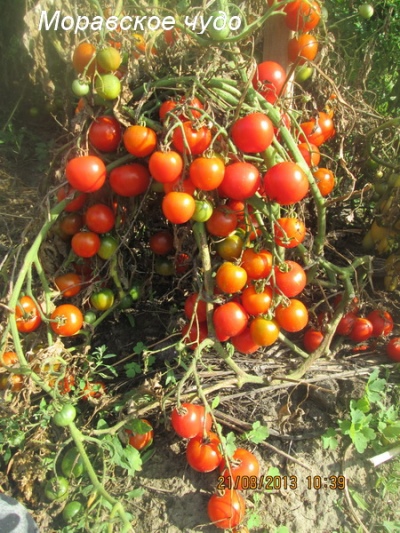
- Authors: IE Aleksashova Marina Vitalievna
- Year of approval: 1997
- Name synonyms: Stupike
- Category: grade
- Growth type: indeterminate
- Appointment: fresh consumption, for pickling and canning, for whole-fruit canning
- Ripening period: early
- Ripening time, days: 83-90
- Growing conditions: for open ground
- Bush size: tall
An excellent variety belonging to the category of Miracle tomatoes. They all have some unique qualities - in color, taste, shape, sometimes all together. The Moravian Miracle (synonym for Stupike) is an early maturing indeterminate variety intended for cultivation in the open field, with cocktail fruits of high marketability, yield and transportability. The berry is used for canning and fresh consumption.
Breeding history
The authorship belongs to IE Aleksashova Marina Vitalievna. The variety was registered in the State Register of Breeding Achievements in 1997.
Description of the variety
Standard tall (140-180 cm) bushes have weak branching with an average degree of foliage. A green leaf plate with a slightly corrugated surface is very similar to a potato one and does not have stipules. Yellow flowers are collected in complex inflorescences, the first of which is laid above 6-7 leaves, all subsequent ones - after 3 cuttings. In the cluster, 7-8 berries are formed, attached to the articulated stalk.
The main qualities of the fruit
Rounded, small (30-42 g), aligned bright red fruits do not have spots and burns. The seed chambers are filled with a small amount of seed.
Taste characteristics
The berry has a sweet dessert taste, slight sourness, delicate tomato aroma. The juicy pulp is covered with a dense, smooth skin, which is almost imperceptible during eating, but protects the tomatoes from cracking, guaranteeing excellent keeping quality and transportability.
Ripening and fruiting
The splendor of the variety also lies in its early maturity - the first fruits ripen within 83-90 days after sowing. Fruiting is extended, the harvest begins from mid-July to September.
Yield
The variety is characterized as high-yielding, which is confirmed not only by weighing, but also by the appearance of the bushes during the ripening of the fruits - they are simply covered with a curtain of berries. From one hectare, from 102 to 240 centners are harvested, which is considered almost a record figure for small-fruited varieties.
The timing of planting seedlings and planting in the ground
The optimal sowing time for seedlings is 55-60 days before planting in a permanent place.

Growing tomato seedlings is an extremely important process, because it largely depends on whether the gardener can harvest at all. All aspects must be taken into account, from seedbed preparation to planting in the ground.
Landing scheme
For the greatest yield of the crop, no more than four roots are planted per square meter.

Growing and care
The variety is grown in the traditional seedling method. Approximately 2 weeks before transplanting young plants to a permanent place, the seedlings begin to harden, taking them outside in the shade, exposing them to open balconies.This technique helps the young to adapt to the surrounding climatic conditions. Gradually, the seedlings should get used to the sun's rays, temperature changes. By the end of the hardening period, the plants should already be spending the night outdoors if they are to grow outdoors.
The place for tomatoes is chosen sunny, protected from winds and drafts. The variety makes high demands on the structure and composition of the soil:
fertility;
average acidity;
good breathability.
If the land does not meet any of the conditions listed above, the tomato will grow, but its potential will remain undiscovered - the yield will be much lower than the declared one, as will the taste.
Acidic soils are deoxidized with dolomite or bone meal, chalk, lime, gypsum. Dense, loamy soil can be made by loose application of cereal husks. Buckwheat husk has a good effect on the composition and structure of the earth. It not only loosens the earth, but also enriches it with macro-, microelements, vitamins, and attracts earthworms from all over the area.
Organic matter (compost, humus, bird droppings) is introduced into the soil prepared for the ridges, complex mineral fertilizers or superphosphate, wood ash are added. Tall bushes need support, so stakes are installed in the holes or a trellis is organized. Plants are planted taking care not to deepen the root collar. Further care consists in the formation of a bush - it is considered optimal to lead in 3 stems. Mandatory pinching will protect the plants from thickening, provide full ventilation and access to fresh air. Watering, weeding, loosening, hilling, sanitizing - traditional procedures for tomatoes are also mandatory for this variety.




A plant needs different micronutrients at each stage of growth. All fertilizers can be divided into two groups: mineral and organic. Folk remedies are often used: iodine, yeast, bird droppings, eggshells.
It is important to observe the rate and period of feeding. This also applies to folk remedies and organic fertilizers.
Disease and pest resistance
Strong immunity and early maturity perfectly protect the variety from such troubles as late blight, apical rot, cladosporium, but does not save from the invasion of pests:
May and Colorado beetles;
leaf-gnawing and melon aphids;
whitefly, bear, spider mite and even wireworm.
The gardener is helped by sanitary preventive treatments of plantings with insecticides and fungicides.


Resistant to adverse weather conditions
The Moravian miracle tomato is distinguished by good health and vitality, it tolerates heat and cold weather well.
Growing regions
The variety is adapted for cultivation in central regions.

























































































